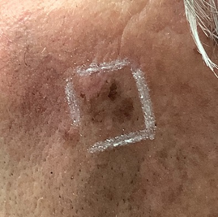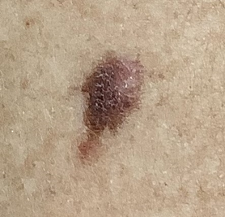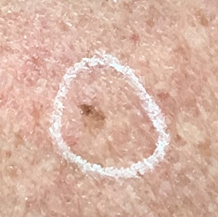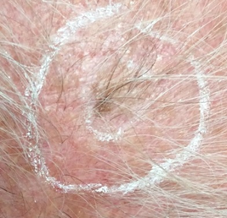By the year 2025, it is estimated that people in the United States will have a 1 in 35 lifetime risk of melanoma. This risk is increasing each year. For instance, in 2024, the lifetime risk of melanoma is 1 in 44 people. It is important to catch melanomas early on, because early detection of melanomas in the epidermis, or superficial layer of the skin, is a 100% cure rate.
At Natural Image OC, our providers are known for their early detection of all skin cancers, including melanoma. They look for are subtle changes in color, size and symmetry. It is important to have full body exams because trained dermatology providers are looking for these specific features that you are likely unaware of. Below is a photo gallery of early melanomas. We want to catch melanomas as early as possible because it is lifesaving. When melanomas are obvious, they are usually deeper and more dangerous.
Dr. Lenore Sikorski can evaluate your condition and recommend the best course of action. Melanoma is serious, but highly curable when caught early. Read on to learn what melanoma is and how it should be treated, where it can appear, and what your treatment options are.
What Is Melanoma?
Melanoma is an invasive skin cancer that begins in the cells of your skin responsible for producing melanin. This is the pigment that gives skin its color, which is in cells that are called melanocytes. Melanoma is an aggressive form of skin cancer because it has a higher tendency to spread to other parts of the body, called metastasis.
Melanoma will often resemble a mole, and sometimes it can develop from an existing mole. This is one reason we recommend you become familiar with the existing moles on your body by doing consistent skin checks and seeing a dermatologist regularly.
You can look for melanoma characteristics that follow the ABCDE rule. Each letter represents a characteristic of this aggressive form of skin cancer.
Asymmetry: one half of the mole does not look like the other half
Border: Melanoma growths typically have an irregular or poorly defined border,
Color: The color typically changes from one area of the mole to another
Diameter: When diagnosed, melanoma is often six millimeters or larger, or about the size of a pencil eraser. But when caught early, they can be smaller.
Evolving: This mole will look different from the rest of the moles on your body and may change in size, shape, or color over time




How Common Is It and Where Can It Appear?
Skin cancer is one of the most common cancers in the U.S. Experts estimate that during their lifetime, one in five people will develop some type of skin cancer. The American Academy of Dermatology reports an estimated 9,500 people are diagnosed with some type of skin cancer each day.
Only 1% of skin cancers are attributed to melanoma, but because it is aggressive and not always caught early, it causes the majority of skin cancer-related deaths. The rate melanoma was diagnosed increased rapidly from 1982 to 2011 but has since begun to decrease in adults 30 years and younger.
Skin cancer can affect anyone without regard to their skin color or age. While melanoma is aggressive, the five-year survival rate when it is detected and treated early is 99%.
Risk factors for melanoma include excess exposure to UV radiation from sunlight or indoor tanning beds. However, melanoma can occur anywhere on the body, including areas that have never been exposed to the sun. We encourage regular skin self-examinations and a consultation with Dr. Sikorski for a routine precancer check.
What Are the Treatment Options for Melanoma?
Once melanoma has been diagnosed and staged, you and Dr. Sikorski will discuss the treatment options that best meet your needs. Surgery is the first-line treatment option, which involves cutting out both the skin cancer and some of the surrounding tissue.
This removal can be done under local anesthesia. The extent of the cancer and whether there is metastasis will determine the treatment steps that follow.
Removal can also be done with Mohs surgery, also called Mohs micrographic surgery. This is a precise technique that involves step-by-step removal and examination of tissue until only healthy, cancer-free tissue remains.
Mohs surgery typically takes several hours because the laboratory must examine the tissue that was removed at each step. Only after what is removed is just healthy tissue is the procedure stopped. After each section is removed, you are asked to wait in the waiting room, so it is helpful to bring something you can do for the morning or the afternoon.
This process is highly effective for cancers that have a high risk of recurrence or are an area where it is important to preserve as much healthy tissue as possible. Natural Image OC offers Mohs micrographic surgery in the treatment of melanoma and other types of skin cancer.
Mohs micrographic surgery is a preferred option for cancers that are aggressive and have poorly defined edges, such as melanoma. The precision of this surgical technique coupled with the high success rate makes it a valuable treatment option in cases where preserving the appearance and function of the area is crucial.
Make an Appointment to Detect and Treat Melanoma Early
When you have a mole that fits one of the ABCDE descriptors or you would like a thorough skin check, please call our office and schedule an appointment with Dr. Sikorski, who can answer your questions and make the best recommendations for your situation. Early melanoma identification and treatment can save your life.
 contact us today
contact us today



